Inferential Statistics in Decision Making: Employee Performance
VerifiedAdded on 2022/08/14
|6
|1136
|16
Report
AI Summary
This report delves into the impact of leadership styles on employee performance, drawing from a qualitative study. The research explores the influence of various leadership approaches, including autocratic, democratic, and participative styles, on employee outcomes. It investigates how different leadership styles affect employee performance, considering both historical and theoretical perspectives. The study highlights the importance of adapting leadership styles to the contemporary business environment, emphasizing the need for employee empowerment. The methodology involves a descriptive research approach using secondary data sources such as journal articles and magazines. The findings indicate that leadership styles significantly impact employee performance, with participative leadership showing a strong positive correlation. The report concludes by emphasizing the importance of understanding how leadership styles shape corporate culture and influence employee engagement and productivity. The study uses inferential statistics to analyze the relationship between leadership styles and employee performance.
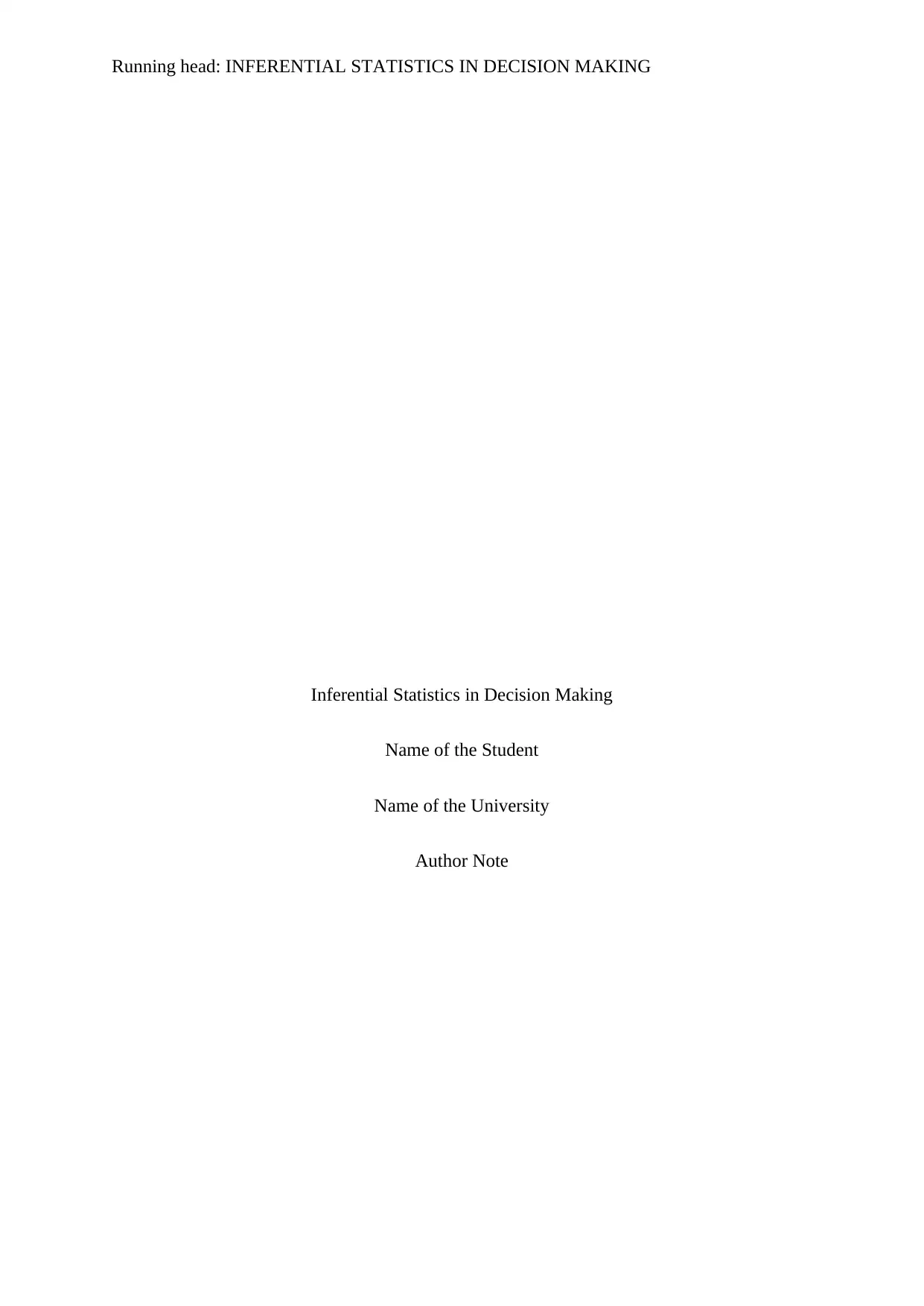
Running head: INFERENTIAL STATISTICS IN DECISION MAKING
Inferential Statistics in Decision Making
Name of the Student
Name of the University
Author Note
Inferential Statistics in Decision Making
Name of the Student
Name of the University
Author Note
Paraphrase This Document
Need a fresh take? Get an instant paraphrase of this document with our AI Paraphraser
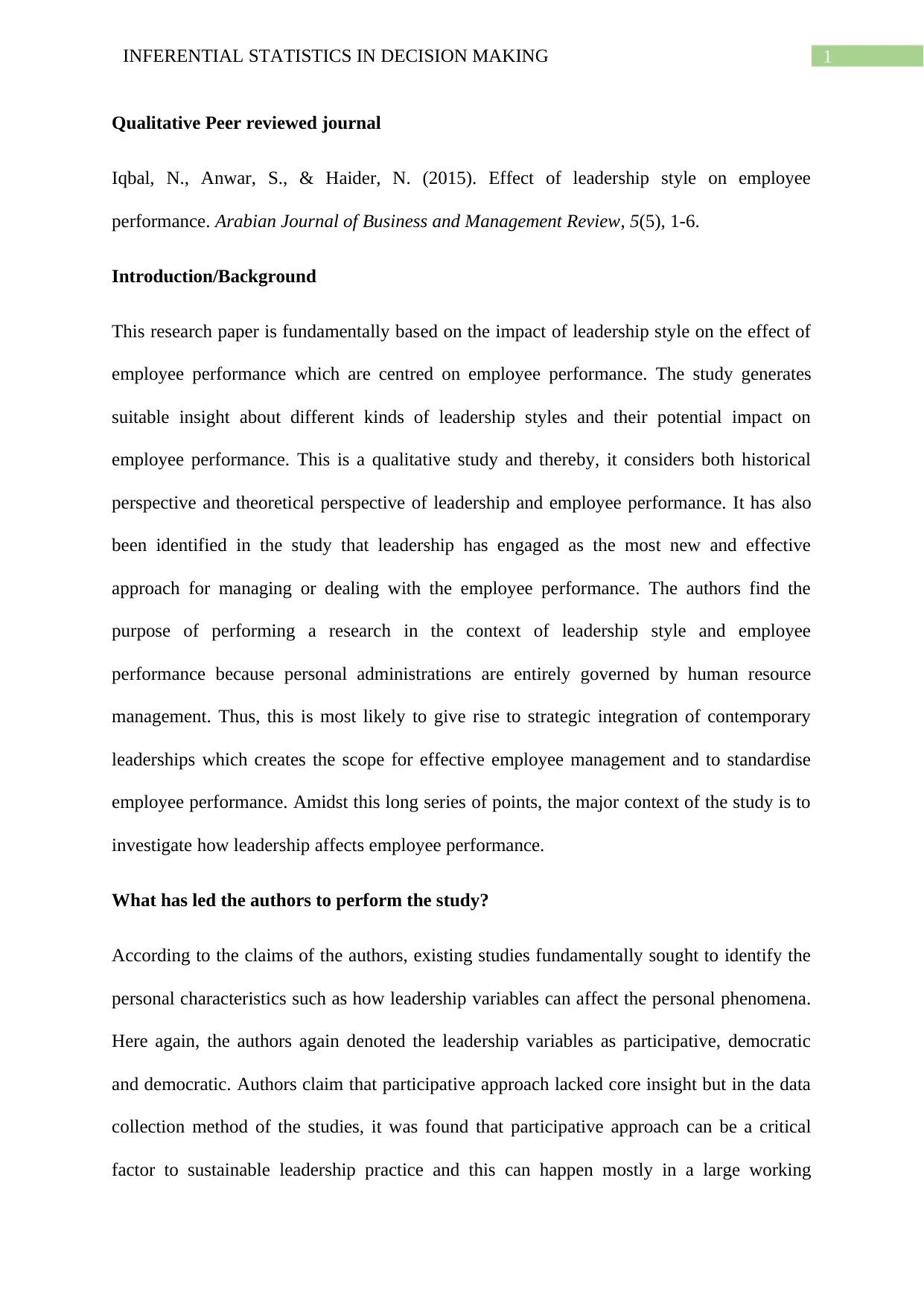
1INFERENTIAL STATISTICS IN DECISION MAKING
Qualitative Peer reviewed journal
Iqbal, N., Anwar, S., & Haider, N. (2015). Effect of leadership style on employee
performance. Arabian Journal of Business and Management Review, 5(5), 1-6.
Introduction/Background
This research paper is fundamentally based on the impact of leadership style on the effect of
employee performance which are centred on employee performance. The study generates
suitable insight about different kinds of leadership styles and their potential impact on
employee performance. This is a qualitative study and thereby, it considers both historical
perspective and theoretical perspective of leadership and employee performance. It has also
been identified in the study that leadership has engaged as the most new and effective
approach for managing or dealing with the employee performance. The authors find the
purpose of performing a research in the context of leadership style and employee
performance because personal administrations are entirely governed by human resource
management. Thus, this is most likely to give rise to strategic integration of contemporary
leaderships which creates the scope for effective employee management and to standardise
employee performance. Amidst this long series of points, the major context of the study is to
investigate how leadership affects employee performance.
What has led the authors to perform the study?
According to the claims of the authors, existing studies fundamentally sought to identify the
personal characteristics such as how leadership variables can affect the personal phenomena.
Here again, the authors again denoted the leadership variables as participative, democratic
and democratic. Authors claim that participative approach lacked core insight but in the data
collection method of the studies, it was found that participative approach can be a critical
factor to sustainable leadership practice and this can happen mostly in a large working
Qualitative Peer reviewed journal
Iqbal, N., Anwar, S., & Haider, N. (2015). Effect of leadership style on employee
performance. Arabian Journal of Business and Management Review, 5(5), 1-6.
Introduction/Background
This research paper is fundamentally based on the impact of leadership style on the effect of
employee performance which are centred on employee performance. The study generates
suitable insight about different kinds of leadership styles and their potential impact on
employee performance. This is a qualitative study and thereby, it considers both historical
perspective and theoretical perspective of leadership and employee performance. It has also
been identified in the study that leadership has engaged as the most new and effective
approach for managing or dealing with the employee performance. The authors find the
purpose of performing a research in the context of leadership style and employee
performance because personal administrations are entirely governed by human resource
management. Thus, this is most likely to give rise to strategic integration of contemporary
leaderships which creates the scope for effective employee management and to standardise
employee performance. Amidst this long series of points, the major context of the study is to
investigate how leadership affects employee performance.
What has led the authors to perform the study?
According to the claims of the authors, existing studies fundamentally sought to identify the
personal characteristics such as how leadership variables can affect the personal phenomena.
Here again, the authors again denoted the leadership variables as participative, democratic
and democratic. Authors claim that participative approach lacked core insight but in the data
collection method of the studies, it was found that participative approach can be a critical
factor to sustainable leadership practice and this can happen mostly in a large working
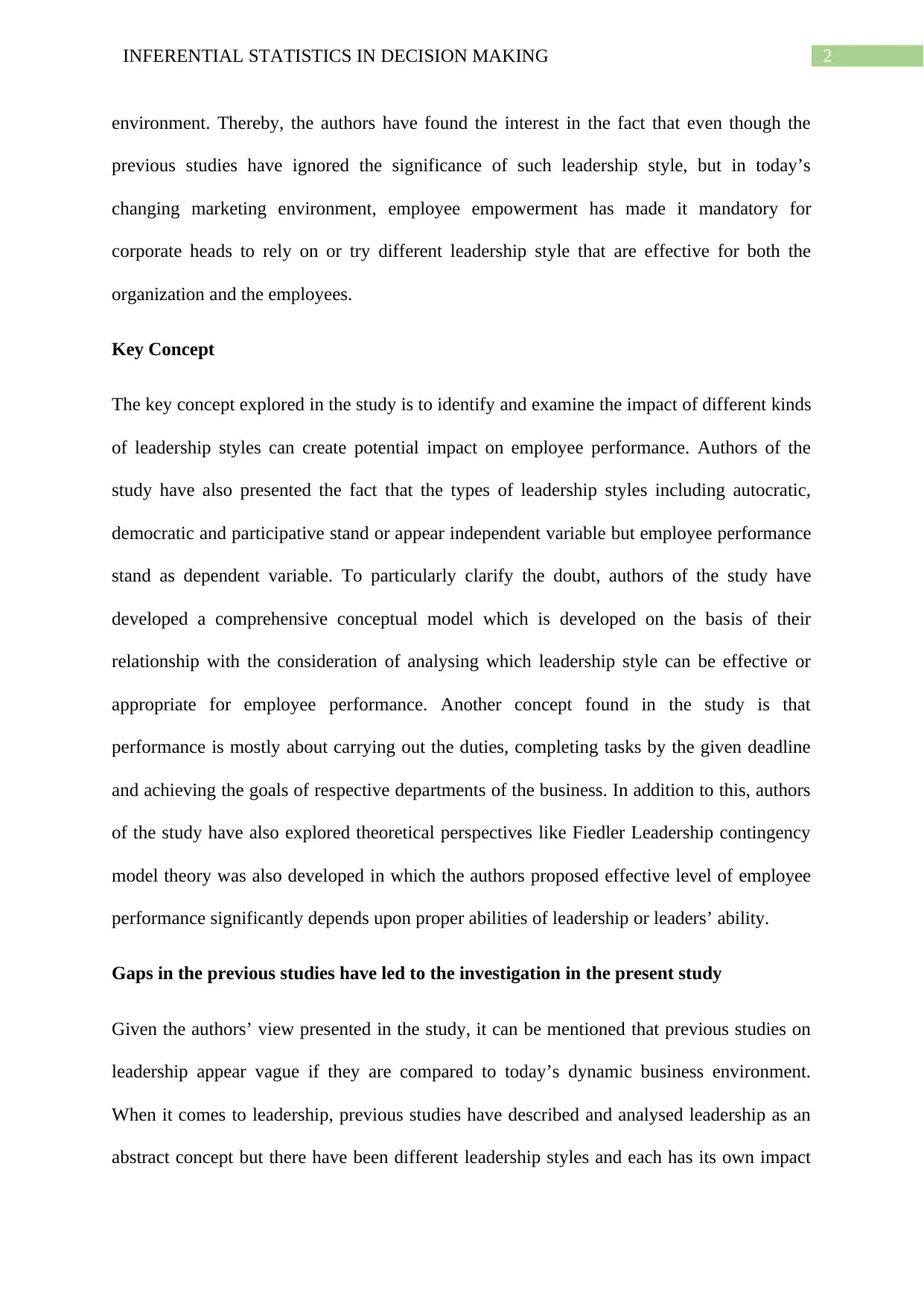
2INFERENTIAL STATISTICS IN DECISION MAKING
environment. Thereby, the authors have found the interest in the fact that even though the
previous studies have ignored the significance of such leadership style, but in today’s
changing marketing environment, employee empowerment has made it mandatory for
corporate heads to rely on or try different leadership style that are effective for both the
organization and the employees.
Key Concept
The key concept explored in the study is to identify and examine the impact of different kinds
of leadership styles can create potential impact on employee performance. Authors of the
study have also presented the fact that the types of leadership styles including autocratic,
democratic and participative stand or appear independent variable but employee performance
stand as dependent variable. To particularly clarify the doubt, authors of the study have
developed a comprehensive conceptual model which is developed on the basis of their
relationship with the consideration of analysing which leadership style can be effective or
appropriate for employee performance. Another concept found in the study is that
performance is mostly about carrying out the duties, completing tasks by the given deadline
and achieving the goals of respective departments of the business. In addition to this, authors
of the study have also explored theoretical perspectives like Fiedler Leadership contingency
model theory was also developed in which the authors proposed effective level of employee
performance significantly depends upon proper abilities of leadership or leaders’ ability.
Gaps in the previous studies have led to the investigation in the present study
Given the authors’ view presented in the study, it can be mentioned that previous studies on
leadership appear vague if they are compared to today’s dynamic business environment.
When it comes to leadership, previous studies have described and analysed leadership as an
abstract concept but there have been different leadership styles and each has its own impact
environment. Thereby, the authors have found the interest in the fact that even though the
previous studies have ignored the significance of such leadership style, but in today’s
changing marketing environment, employee empowerment has made it mandatory for
corporate heads to rely on or try different leadership style that are effective for both the
organization and the employees.
Key Concept
The key concept explored in the study is to identify and examine the impact of different kinds
of leadership styles can create potential impact on employee performance. Authors of the
study have also presented the fact that the types of leadership styles including autocratic,
democratic and participative stand or appear independent variable but employee performance
stand as dependent variable. To particularly clarify the doubt, authors of the study have
developed a comprehensive conceptual model which is developed on the basis of their
relationship with the consideration of analysing which leadership style can be effective or
appropriate for employee performance. Another concept found in the study is that
performance is mostly about carrying out the duties, completing tasks by the given deadline
and achieving the goals of respective departments of the business. In addition to this, authors
of the study have also explored theoretical perspectives like Fiedler Leadership contingency
model theory was also developed in which the authors proposed effective level of employee
performance significantly depends upon proper abilities of leadership or leaders’ ability.
Gaps in the previous studies have led to the investigation in the present study
Given the authors’ view presented in the study, it can be mentioned that previous studies on
leadership appear vague if they are compared to today’s dynamic business environment.
When it comes to leadership, previous studies have described and analysed leadership as an
abstract concept but there have been different leadership styles and each has its own impact
⊘ This is a preview!⊘
Do you want full access?
Subscribe today to unlock all pages.

Trusted by 1+ million students worldwide
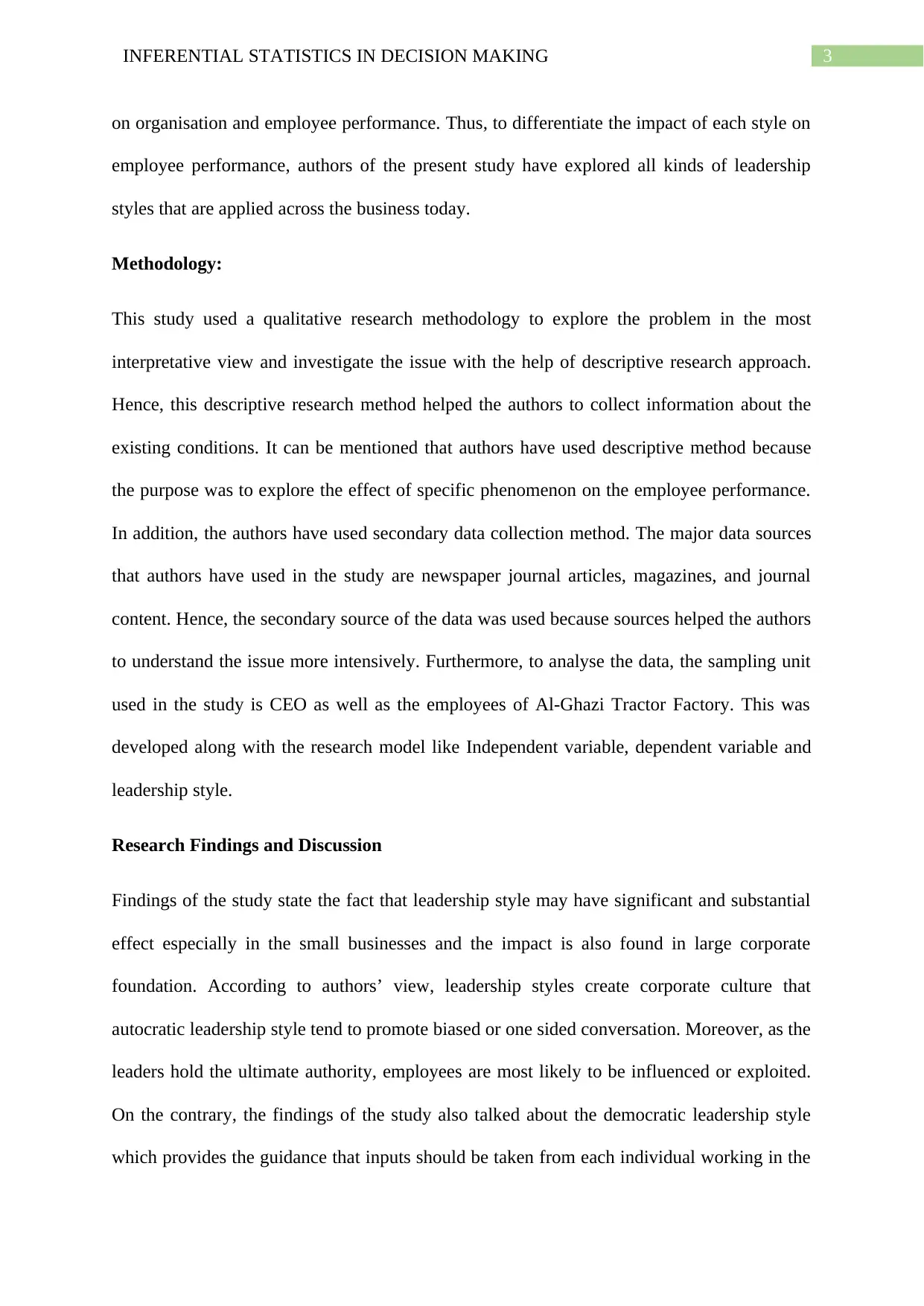
3INFERENTIAL STATISTICS IN DECISION MAKING
on organisation and employee performance. Thus, to differentiate the impact of each style on
employee performance, authors of the present study have explored all kinds of leadership
styles that are applied across the business today.
Methodology:
This study used a qualitative research methodology to explore the problem in the most
interpretative view and investigate the issue with the help of descriptive research approach.
Hence, this descriptive research method helped the authors to collect information about the
existing conditions. It can be mentioned that authors have used descriptive method because
the purpose was to explore the effect of specific phenomenon on the employee performance.
In addition, the authors have used secondary data collection method. The major data sources
that authors have used in the study are newspaper journal articles, magazines, and journal
content. Hence, the secondary source of the data was used because sources helped the authors
to understand the issue more intensively. Furthermore, to analyse the data, the sampling unit
used in the study is CEO as well as the employees of Al-Ghazi Tractor Factory. This was
developed along with the research model like Independent variable, dependent variable and
leadership style.
Research Findings and Discussion
Findings of the study state the fact that leadership style may have significant and substantial
effect especially in the small businesses and the impact is also found in large corporate
foundation. According to authors’ view, leadership styles create corporate culture that
autocratic leadership style tend to promote biased or one sided conversation. Moreover, as the
leaders hold the ultimate authority, employees are most likely to be influenced or exploited.
On the contrary, the findings of the study also talked about the democratic leadership style
which provides the guidance that inputs should be taken from each individual working in the
on organisation and employee performance. Thus, to differentiate the impact of each style on
employee performance, authors of the present study have explored all kinds of leadership
styles that are applied across the business today.
Methodology:
This study used a qualitative research methodology to explore the problem in the most
interpretative view and investigate the issue with the help of descriptive research approach.
Hence, this descriptive research method helped the authors to collect information about the
existing conditions. It can be mentioned that authors have used descriptive method because
the purpose was to explore the effect of specific phenomenon on the employee performance.
In addition, the authors have used secondary data collection method. The major data sources
that authors have used in the study are newspaper journal articles, magazines, and journal
content. Hence, the secondary source of the data was used because sources helped the authors
to understand the issue more intensively. Furthermore, to analyse the data, the sampling unit
used in the study is CEO as well as the employees of Al-Ghazi Tractor Factory. This was
developed along with the research model like Independent variable, dependent variable and
leadership style.
Research Findings and Discussion
Findings of the study state the fact that leadership style may have significant and substantial
effect especially in the small businesses and the impact is also found in large corporate
foundation. According to authors’ view, leadership styles create corporate culture that
autocratic leadership style tend to promote biased or one sided conversation. Moreover, as the
leaders hold the ultimate authority, employees are most likely to be influenced or exploited.
On the contrary, the findings of the study also talked about the democratic leadership style
which provides the guidance that inputs should be taken from each individual working in the
Paraphrase This Document
Need a fresh take? Get an instant paraphrase of this document with our AI Paraphraser
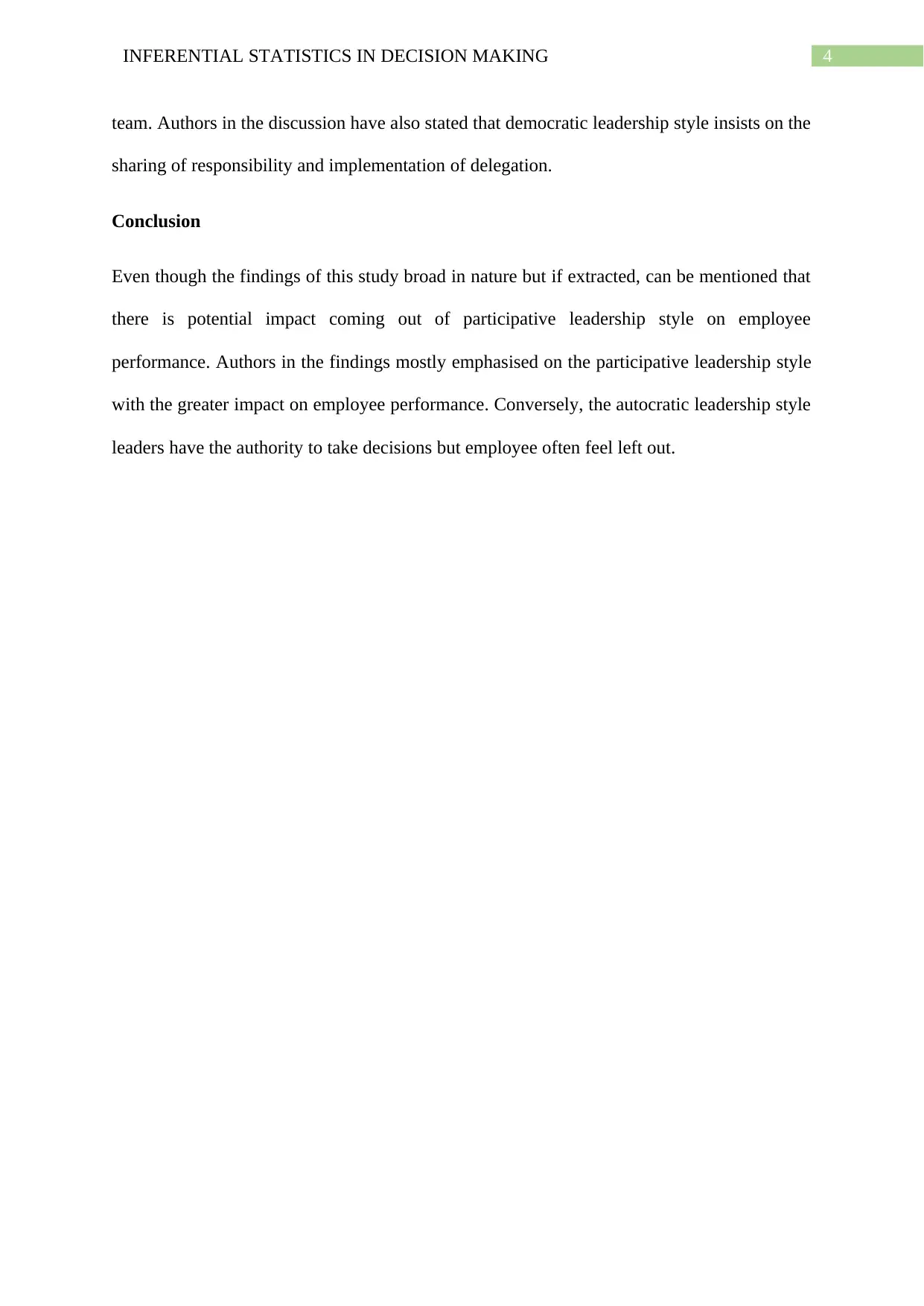
4INFERENTIAL STATISTICS IN DECISION MAKING
team. Authors in the discussion have also stated that democratic leadership style insists on the
sharing of responsibility and implementation of delegation.
Conclusion
Even though the findings of this study broad in nature but if extracted, can be mentioned that
there is potential impact coming out of participative leadership style on employee
performance. Authors in the findings mostly emphasised on the participative leadership style
with the greater impact on employee performance. Conversely, the autocratic leadership style
leaders have the authority to take decisions but employee often feel left out.
team. Authors in the discussion have also stated that democratic leadership style insists on the
sharing of responsibility and implementation of delegation.
Conclusion
Even though the findings of this study broad in nature but if extracted, can be mentioned that
there is potential impact coming out of participative leadership style on employee
performance. Authors in the findings mostly emphasised on the participative leadership style
with the greater impact on employee performance. Conversely, the autocratic leadership style
leaders have the authority to take decisions but employee often feel left out.
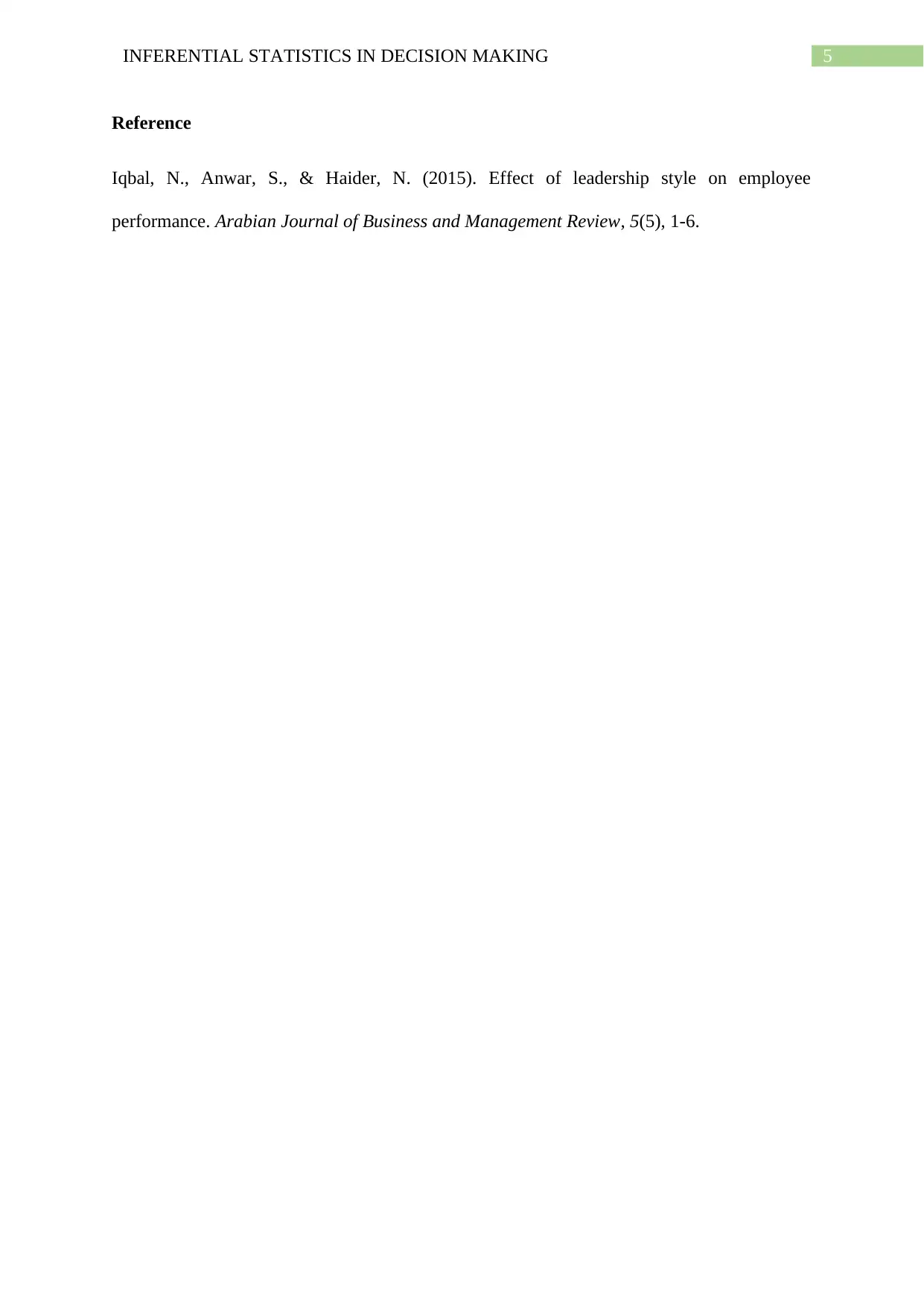
5INFERENTIAL STATISTICS IN DECISION MAKING
Reference
Iqbal, N., Anwar, S., & Haider, N. (2015). Effect of leadership style on employee
performance. Arabian Journal of Business and Management Review, 5(5), 1-6.
Reference
Iqbal, N., Anwar, S., & Haider, N. (2015). Effect of leadership style on employee
performance. Arabian Journal of Business and Management Review, 5(5), 1-6.
⊘ This is a preview!⊘
Do you want full access?
Subscribe today to unlock all pages.

Trusted by 1+ million students worldwide
1 out of 6
Related Documents
Your All-in-One AI-Powered Toolkit for Academic Success.
+13062052269
info@desklib.com
Available 24*7 on WhatsApp / Email
![[object Object]](/_next/static/media/star-bottom.7253800d.svg)
Unlock your academic potential
Copyright © 2020–2025 A2Z Services. All Rights Reserved. Developed and managed by ZUCOL.




